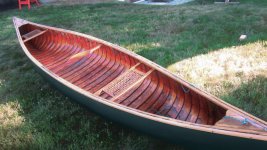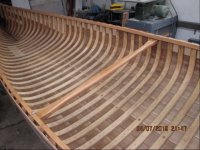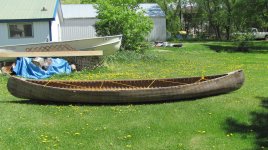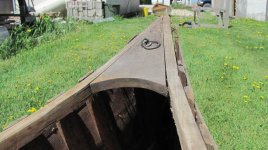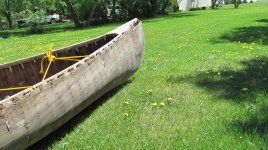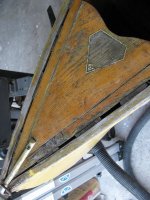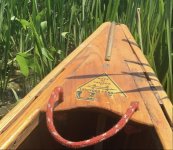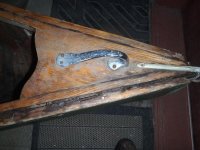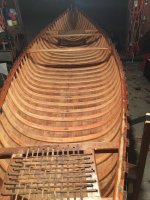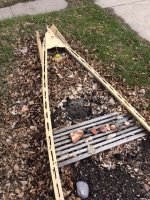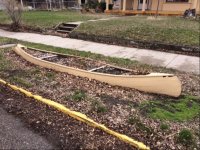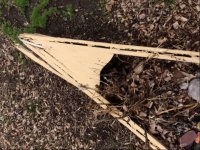I posted some pictures on the WCHA forum of a canoe I picked up last week. Supposedly it came from somewhere in northern Ontario, but has no markings. It has some things in common with a Langford from the 60's, but I think the decks don't quite match. It certainly isn't a Lakefield regardless of the deck sticker.
According to the previous owner, it originally had slat seats that were mounted to the gunwales with a horizontal rail instead of typical drops. Overall, the build quality appears to be more utilitarian, although all fasteners are either brass or bronze. There are no broken ribs, but the canoe has a few ribs with creases in them from poor steam bending. The canoe is in surprisingly good shape, having no rot in either stems, so it must have been very well taken care of. The canoe is a bit heavier without canvas than my OT HW, but it does have a bit more wood in the construction and the hull seems to be quite saturated with oil.
The canoe is 16' long overall and 36" wide at the widest part of the hull. Ribs are un-tapered and 1-7/8" wide, roughly 5/16" thick and spaced 1-1/8" apart. I can't tell if they are made of white cedar, but may be something else. Planking is 5/32" thick and 3-3/4" wide and is definitely western red cedar. Some of the planking and ribs are nice quality quarter sawn stock, while plank at the bilge area is flat sawn for some reason. Decks and thwarts are ash. I think the decks are original. Gunwales are some species of soft wood, spruce or fir and are built quite heavy being 1-1/16" high. Inwales are 15/16" thick and have a minimal bevel since the canoe has almost no tumblehome. Outwales are 7/8" wide.
At center, the canoe is approximately 14-1/2" deep, and at the ends is 25" . The keel line is almost flat and raises only near the stems. It's profile is similar to an Abenaki canoe in the Adney book, but is built more full in the ends like a prospector.
Any other ideas of a maker from our friends north of the border?
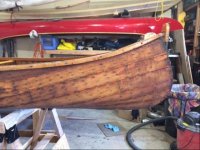
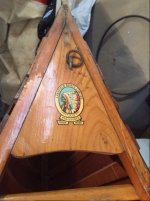
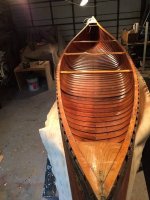
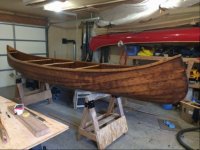
According to the previous owner, it originally had slat seats that were mounted to the gunwales with a horizontal rail instead of typical drops. Overall, the build quality appears to be more utilitarian, although all fasteners are either brass or bronze. There are no broken ribs, but the canoe has a few ribs with creases in them from poor steam bending. The canoe is in surprisingly good shape, having no rot in either stems, so it must have been very well taken care of. The canoe is a bit heavier without canvas than my OT HW, but it does have a bit more wood in the construction and the hull seems to be quite saturated with oil.
The canoe is 16' long overall and 36" wide at the widest part of the hull. Ribs are un-tapered and 1-7/8" wide, roughly 5/16" thick and spaced 1-1/8" apart. I can't tell if they are made of white cedar, but may be something else. Planking is 5/32" thick and 3-3/4" wide and is definitely western red cedar. Some of the planking and ribs are nice quality quarter sawn stock, while plank at the bilge area is flat sawn for some reason. Decks and thwarts are ash. I think the decks are original. Gunwales are some species of soft wood, spruce or fir and are built quite heavy being 1-1/16" high. Inwales are 15/16" thick and have a minimal bevel since the canoe has almost no tumblehome. Outwales are 7/8" wide.
At center, the canoe is approximately 14-1/2" deep, and at the ends is 25" . The keel line is almost flat and raises only near the stems. It's profile is similar to an Abenaki canoe in the Adney book, but is built more full in the ends like a prospector.
Any other ideas of a maker from our friends north of the border?





